So, you’ve finally given in and decided it was time to add some quail to your home, you’ve placed your order, and now it’s time to prepare a home, Quail Coop, for your new tenants.
Once they arrive, they will be itching to get comfortable in the duds you have created for them.
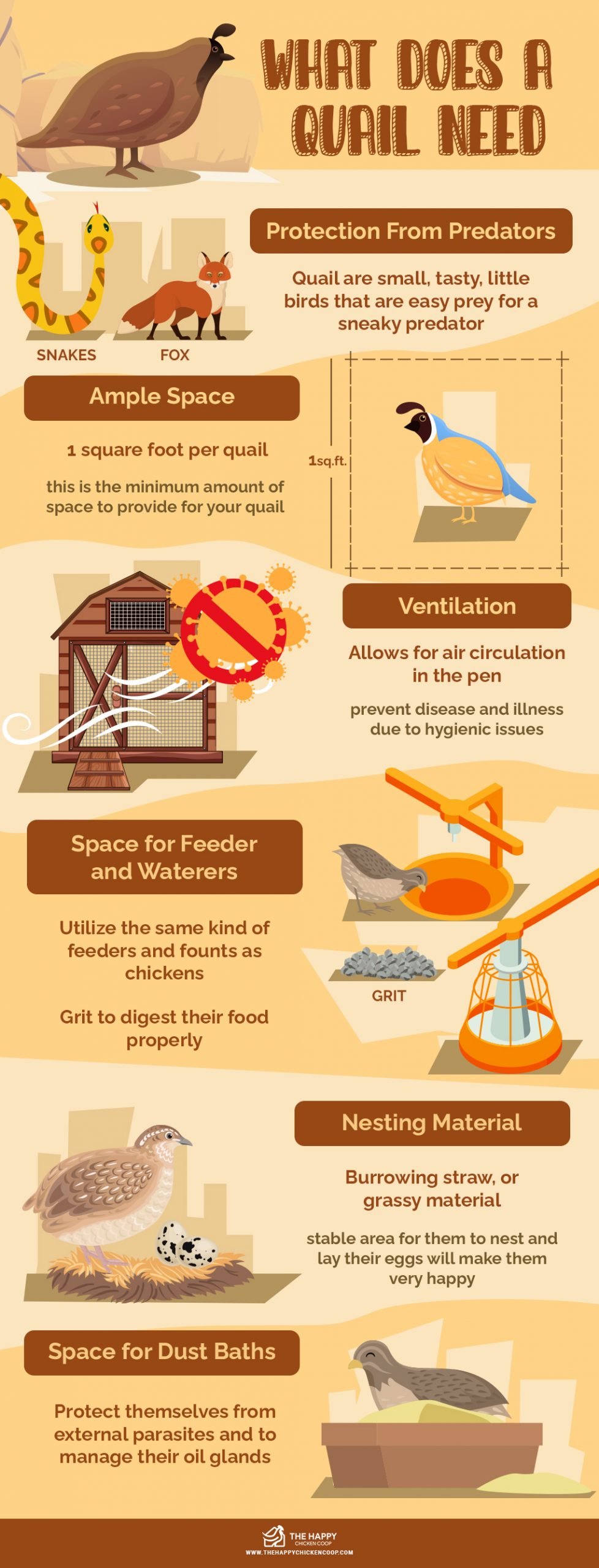
What Does a Quail Need?
Quail are game birds and can be relatively similar to chickens. Some even raise them together, but there are a few different considerations when planning your quails’ housing requirements.
Let’s break down the essential elements for quail pens:
Protection From Predators
Quail are small, tasty, little birds that are easy prey for a sneaky predator. Whether you are building an indoor hutch or an outdoor run, special care must be taken to ensure all nooks and crannies are addressed and eliminated.
Even the smallest opening can be just enough for a snake or slinky rat to sneak into and start a quail massacre.
Due to the quails’ small stature, they are at risk of becoming a predator’s meal, and the number of predators to deter is much more than other kinds of barnyard birds.
For example, a fox can burrow under an outdoor pen and have a feast on your quails if a barrier is not placed beneath the ground to discourage the sly predator.
Snakes, which would not usually be large enough to eat a whole chicken, can easily consume a quail, and guess how easy it is for snakes, and other small predators, to get into pens that were put together lazily?
Yup, extremely easy, and this is why a lot of quail keepers have decided to keep their small game birds in welded wire cages, typically kept indoors.
Ample Space
While it is true that many quail can be kept in a small space, it is always more polite to allow your quail plenty of elbow room.
The general rule of thumb is to allow 1 square foot per quail in any enclosure. Keep in mind this is the minimum amount of space to provide for your quail, and they would undoubtedly appreciate much more than that.
Keep in mind that quail come in many different shapes and sizes depending upon the breed you select. The larger the quail, the more space they will need in their pen, and as always, the more, the better!
Ventilation
Speaking of space requirements, always keep in mind that the more birds you squish into a small space, the more feces you will be dealing with.
The thing about quails is, their dropping have quite a high level of ph, which means the possibility of a higher concentration of ammonia and respiratory problems.
Ensuring that you are cleaning your quails’ cages often will help prevent disease and illness due to hygienic issues, but also allows for air circulation in the pen, and if kept in a building, within the building itself.
It can be easy to get carried away with the amount of quail you have at one time, they are, after all, easy to care for, and come in small packages.
Always make sure you are cleaning their cages, food, and waterers, regularly.
Space for Feeder and Waterers
Don’t forget that you will need to leave room for water founts and feeders in your pens. Quail utilize the same kind of feeders and founts as chickens, so depending upon how many quail you have, you should account for the space needed for these devices.
If you decide to use a small cage for your quail, you can consider swapping out founts for nipples that release water when agitated by the quail. Nipple waterers free up a considerable amount of space and keep their water clean. Nipples can be used for outdoor housing as well.
Along with food and water sources, you should also allow for space for grit. Like chickens, quail need the grit to digest their food properly. Think of grit like teeth; they are an essential part of the digestive process.
Keep in mind that quail enjoy foraging for their food, and they will take to scratching at their grit, so leaving enough space to allow for this will nurture their instincts and let them have what they need to digest their food correctly.
Nesting Material
Unlike chickens, quail do not roost. Yes, they fly, but they enjoy spending much of their time on the ground. At night, they tend to nest in whatever material you provide for them.
Depending upon the type of quail you have, they may enjoy burrowing straw, or grassy material, as they would in the wild.
If they are in a welded wire cage, providing a stable area for them to nest upon and lay their eggs will make them very happy.
Additionally, if you are keeping your quail in wire-bottomed cages, you probably want to stay away from shavings of any kind, as they will easily fall through the bottom of your pen, as well as through the sides during an intense scratching session.
Space for Dust Baths
Quail take spa days too, and they do so to protect themselves from external parasites and to manage their oil glands.
Giving your quail a small area to take baths in will help keep them pest-free and hygienically happy.
Remember, your quail are little, so an area to take dust baths does not have to take up too much space. You may even find that your quail lays eggs in their dust bath space.
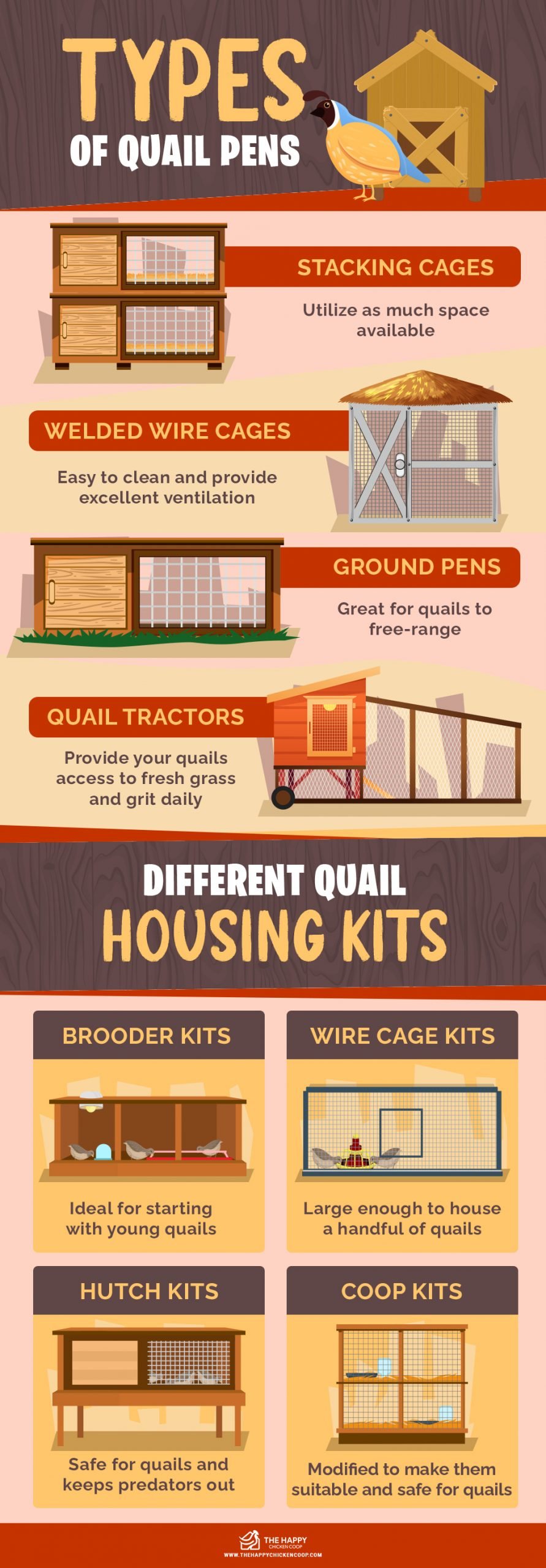
Types of Quail Pens
Recently, options for how to raise your quail have increased. The majority of quail raised for meat, eggs, or as pets are kept in wire cages.
The beautiful thing about quail is that they do very well in confinement, so if you are limited on space, your quail can live happily in a cage in your garage, or on your porch.
There is nothing wrong with keeping quails in cages, they don’t mind and probably won’t complain too much either.
With that being said, raising quail outdoors has begun increasing in popularity. People enjoy watching their favorite birds hunt and peck for protein and grit in their natural environment.
Some believe raising quail in anything but a cage is unsafe for the quail and a waste of time. However, there are plenty of options and solutions for keeping your quail safe in either type of environment.
Stacking Cages
If you plan to raise a lot of quail, and you need to utilize as much space available due to spatial limitation, stacked cages are an excellent option.
These come pre-made or, if you are handy, you can build your own stacking cage with 1/2″ or 1″ galvanized wire.
If you are keeping your stacked cages outdoors, consider smaller woven wire, to protect your quail from predators.
If you decide to make your own cages, make sure that you are allowing for proper ventilation where you will be keeping your quail.
Give yourself enough space for ease of cleaning, and include trays that separate one cage from another, so droppings do not fall into cages below.
Welded Wire Cages
Welded-wire cages can come in the form of rabbit cages, stacked cages, or a cage you have created based on your required specifications. These are the kind of pens that many quail are kept in because they are easy to clean and provide excellent ventilation.
They are also easy to hang watering systems and feeders from, which assists in keeping things just a little cleaner for a little longer.
Wire cages are often raised off the ground with a stand made from either metal or wood. If you prefer to allow droppings to fall to the ground, a trayless cage with a 1/2″ wire on the bottom will be the most favorable.
Alternatively, if you chose to keep your quail indoors, on a table, make sure the cage you create has a tray under the wire for easy cleaning.
Ground Pens
Ground pens are great for those who would prefer to free-range their quail but aren’t quite comfortable allowing their little birds to have free rein over the yard.
Ground pens are a great alternative to free-ranging because they protect quail from predators, and the elements, but also allow them to have access to the natural ground where they can take dust baths and just be quails.
If you have ample amount of space, you can create large ground pens that allow for your quail to stretch their wings, scratch for grit, and seek out vegetation and protein in the form of bugs.
Think about creating a tall aviary for your quail in which they can fly about and burrow. This kind of paradise can also be quite eye-catching and entertaining.
Ground pens are typically constructed of a mixture of galvanized wire fencing, mesh netting, and a wooden frame. Chicken wire can be used, but if you plan to allow your quail hens to raise their chicks, take extra precautions because they will be able to leave the pen through the small openings.
Additionally, small snakes and rats can enter through the chicken wire and eat juvenile quail. Mesh-like fencing is the best option for a round pen with young birds.
If you decide to build a ground pen, your quail will need exceptional protection from looming predators.
Because quail can fly vertically, you will need to install a roof, or poultry netting at the top of your pen to keep your quail in and aerial predators, like hawks, owls, and eagles, out.
Quail Tractors
Just like a rabbit or chicken tractor, your quail can enjoy the benefits of a mobile pen. If you want to provide your quails access to fresh grass and grit daily, you can create temporary, movable pens for them.
Since the construction of these pens has to be conducive to moving them daily, they should be light enough, or able to be pulled behind your tractor.
Because of this, the extra safety measures may not be able to be as easily implemented due to the added weight of additional boarding, height, or wiring.
While this may sound like a pain, quail tractors work best for quail that you can bring back into the safety of their wire cages in the evening or during bad weather.
That is not to say that a safe mobile quail pen cannot be created for 24/7 use, just be sure not to bite off more weight than you can chew for moving daily.
Quail scratch for grit, seeds, and bugs, however, they are not nearly as destructive as chickens. Still, if you value a thick lawn, you should be prepared to move your quail daily if their home is mobile.
Below is an example of what a mobile pen looks like and can be used for quail.
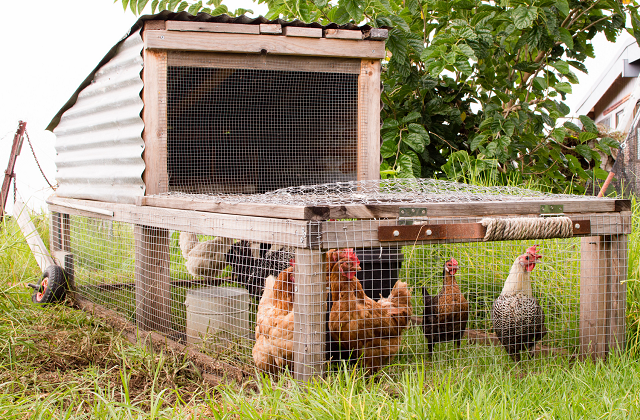
How to Build a Welded Wire Pen
Building your own pen isn’t as daunting as you may think. If you’ve decided to forgo a ground pen or outdoor coop, you are probably considering a galvanized wire pen.
These are easy to clean and maintain. Your quail will appreciate as much room as possible, so be sure to be generous when measuring for your pen.
What You Need to Build a Welded Wire Pen
- 1/2 inch welded wire for the bottom
- 1 inch welded wire for the remainder (or smaller if needed)
- J Clips
- Wire Clip Pliers (crimper)
- Wire cutters
- Plastic or Metal tray made from sheet metal
Directions for Building a Quail Pen
-
Cut Bottom of Cage
Make sure that before you begin cutting the wire, you know how large your cage will be based on the breed of quail you are housing, the size, and the number of quail per pen.
Remember to give each adult quail 1 square foot per bird and don’t forget to plan for feeders, waterers, and dust baths.
Measure the 1/2” wire for the bottom of the cage. Then, using your wire cutters, cut the bottom to specifications. Be careful; the cut wire can be sharp!
-
Cut the Sides of the Cage
Using the 1” inch wire, for indoor pens, or the 1/2” wire for outdoor enclosures, carefully cut the sides of your pen.
-
Connect the Sides with J-Clips
Using j-clips and your wire pliers, crimp the clips tightly, joining each sheet of wire to create your cage. Depending upon the size of your pen, you can use more or fewer j-clips to ensure the sides are held together tightly.
You want your pen to be extremely sturdy with zero gaps.
Note: You will j-clip the top of your cage initially, but in the next step you will cut an opening for access to your quail.
-
Cut Openings for a Door, Feeders, and Waterers
If you are using hanging waterers, nipples, or feeders, you may need to cut openings for them. Plan accordingly before you begin to cut any openings.
Think about where you will be placing the dust bath, and make sure to measure the size needed for the opening before you begin.
Give yourself plenty of space when cutting the opening to your cage. Use the top as your “door.” Cut about 3-4” from the sides of the top of the pen on all four sides. Try your best to remove all sharp edges from the wires you have just cut.
Using more j-clips, loosely clip the top of the cage, on one long side, back onto the pen, to use as your door.
-
Add Flooring for Tray (optional)
If you are adding a tray to your cage, j-clip another sheet of 1/2” wire, about an inch from the bottom of your pan to separate your quail from the droppings tray.
You may need to use quite a few more j-clips to ensure the wire sheet (flooring) is stable and sturdy.
Different Quail Housing Kits
If you aren’t very handy, don’t fret, there are plenty of kits and pre-made cages available to you. Sometimes it’s easier to simply purchase a kit rather than gathering all the equipment needed and spending time on building a pen.
Some kits have everything you need to get started, and I mean everything! They may be purchased as a pre-made cage or a hutch that has minimal assembly required.
Some kits include trays, starter feed, waterers, perches, and the list goes on.
Let’s take a look at a couple of different kinds of kits that make getting started with quail easy:
Brooder Kits
If you are starting with young quail, your first bit of housing will not be a pen or a coop, but a brooder.
Young quail need heat to survive, and develop, just like baby chickens.
Brooder kits are relatively inexpensive and can come with a brooder box made from anything from cardboard to rubber tubs. Kits may also include informational material, feeders, waterers, and in some cases, even feed.
If you are looking at brooder kits that come with feed, make sure it is game bird starter feed, and not chicken starter feed. Both of these babies have different needs when it comes to protein.
Wire Cage Kits
Rather than a kit, wire cages usually come completed, and ready for your birds. However, you can get a bundle of stacked-wire cages, for example, if you are hoping to raise a lot of quail.
Sometimes these bundles will either recommend or include the best type of waterers and feeders to fit the specifications of the pens being purchased.
If you are looking for just a simple wire cage, you can easily opt for an uncomplicated rabbit cage.
Pens created for other small animals and pets can work well for quail because they often include pull-out trays that allow for easy cleaning, and they are large enough to house a handful of quail–depending upon the breed you chose to raise.
Hutch Kits
Searching for hutch kits will usually land you on rabbit raising websites, which is perfectly fine because rabbit hutches are built to protect a vulnerable rabbit from predators; thus, it can also be considered safe for quail.
The only stipulation here is to make sure the hutch has wiring that is closer to 1/2″ to keep predators out, especially if your pen will be outdoors.
Coop Kits
You probably won’t find many kits available for ground pens, because most of them have been tweaked by handy quail hobbyists with various items that make them suitable and safe for quail.
However, you can find small coops and hutches at your local agriculture store, or online.
Coop kits can be basic or snazzy. Some look like little barns or houses, and some are pretty plain. Features of these coops might be geared more toward chickens with nesting boxes and roosts, or even rabbits with runs (which your quail will enjoy as well).
So, take care to ensure you are meeting the needs of your quail with the coop you have your eye on.
If you decide to order any kits online, always read the specifications, making sure they are large enough for the number of birds you plan on housing, and make sure the materials are quality.
These kinds of kits may get a bit costly, so you want to be sure they will last your birds for years to come.
You Aren’t Married to The Pen You Choose
As you get started with quail, you will begin to learn the ins and outs of what they need, what they like, and how you prefer to care for them.
If at any point you decide an outdoor pen is not working for your quail, you can always move them back inside, and vice versa. Remember, quail may have different cage needs depending on what you are raising them for.
The specifics vary whether you are raising quail for sport, meat, and eggs, or just want them as pets.
The most important thing is that your quail have everything they need to thrive in a healthy environment.
The great thing about quail is that they aren’t picky, and can acclimate to a variety of different enclosures, so rest easy knowing that the options are endless.
Once your pen is complete, and your quail are happy and thriving, you can enjoy them and the products they produce in return for your hard work and care.
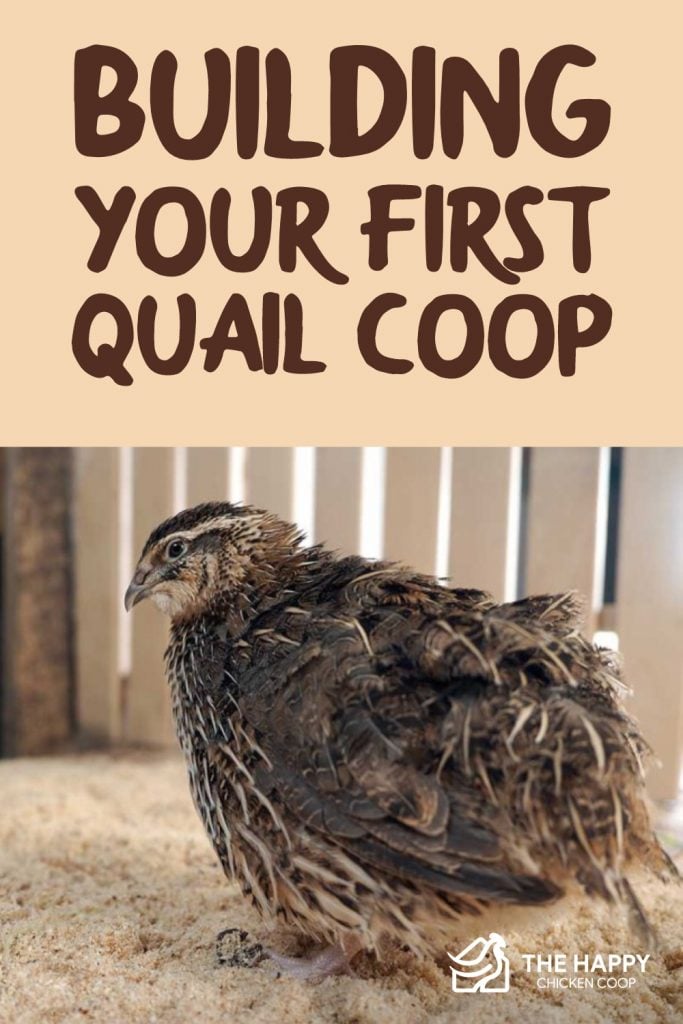
Disclosure: We may earn affiliate commissions at no cost to you from the links on this page. This did not affect our assessment of products. Find full disclosure here.



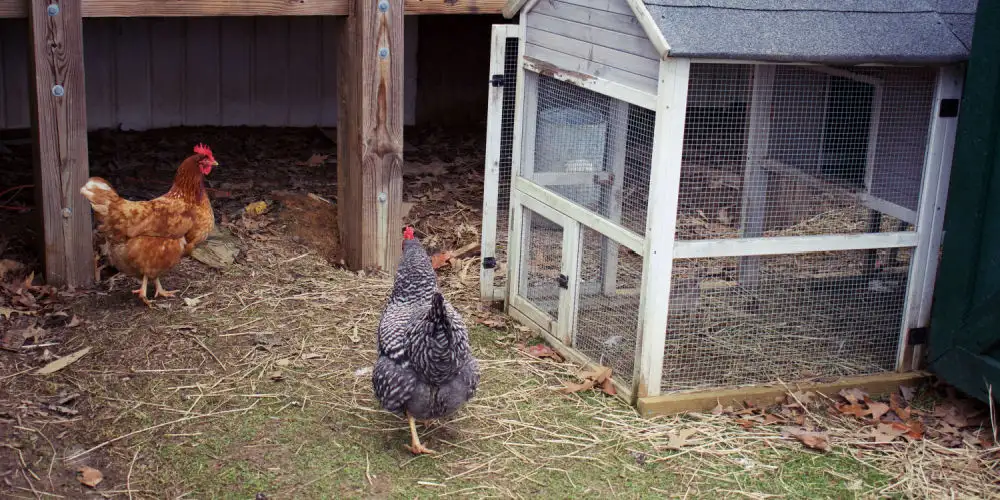
Did you really mean to say one square INCH of space for each quail when planning for a coop/enclosure? That’s only about a third of the size of this comment box.
square foot, thankyou for bring this to our attention, it has been corrected
When you ask people for advice on a good type of bird feeder, many will tell you that there is no one type that is best. They have various reasons for thinking so. There is the issue of size to consider as well as the location of the feeder relative to the home or property of the potential bird visitor.
Great article! I’m definitely considering building a quail coop for my backyard. I love the idea of raising quail for their eggs and meat. Can you provide more information on the best layout and design for a quail coop? I’m new to this and want to make sure I get it right.